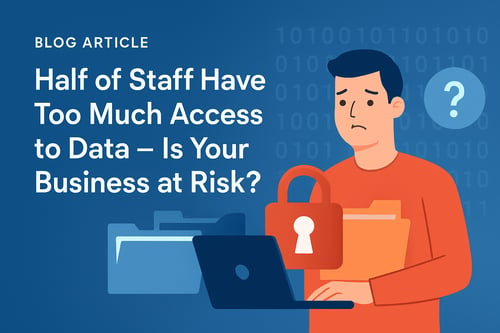Half of Staff Have Too Much Access to Data – Is Your Business at Risk?
Most business owners in North Queensland know the pain of IT problems.
The email system crashes. A staff member clicks the wrong link. A server goes down in the middle of payroll. Suddenly, your team can’t work, customers are frustrated, and you’re stuck waiting for someone to come and “fix it.”
On the surface, this kind of break/fix IT feels cheaper. After all, you only pay when something goes wrong. But the truth is, reactive IT costs more than you think — in ways that hit harder than a service invoice.
- Downtime drains profits → Every hour without systems costs staff productivity, lost sales, and reputation.
- Security gaps stay open → Cyber criminals exploit outdated software and poor monitoring long before you notice.
- Compliance risks increase → Insurance claims or audits often fail if IT systems aren’t proactively managed.
- Leaders get distracted → Instead of focusing on growth, owners are pulled into IT firefighting.
The Real Cost of Downtime
Every hour your systems are down is an hour of lost productivity. Staff are idle, customers are waiting, and deadlines slip.
Research shows downtime can cost Australian SMEs thousands per hour — and in sectors like construction, healthcare, or professional services, those costs multiply quickly.
But downtime isn’t just about money. It also erodes staff confidence (“IT never works here”) and customer trust (“if they can’t get their own systems right, how can I trust them with my job?”).
Surprise Bills & No Predictability
With break/fix IT, you never know what the next bill will be. One month it’s nothing, the next it’s thousands. That unpredictability makes it hard to budget — and harder to plan for growth.
Worse, most fixes are short-term patches. They get you back online today, but they don’t address the root cause. Which means you’ll likely face the same issue again, paying for it twice.
Security Gaps Left Wide Open
Cyber threats don’t wait until your IT provider is available.
Most attacks happen outside of business hours, and relying on a reactive model means you’re exposed. No patching, no monitoring, no proactive training = big risks.
And when a breach does happen, insurers and regulators are asking hard questions: “Did you have protections in place?” If the answer is no, you could face rejected claims, fines, and reputational damage.
The Opportunity Cost of “Just Getting By”
Perhaps the biggest hidden cost of reactive IT is lost opportunity.
Instead of using technology to streamline operations, empower staff, or delight customers, you’re stuck firefighting. IT becomes a barrier, not an enabler.
Your competitors who invest in proactive IT aren’t just avoiding downtime — they’re getting ahead. They’re leveraging secure cloud, automation, and better communication tools to work smarter and scale faster.
A Better Way Forward
The good news? You don’t have to stay stuck in the break/fix cycle.
With a proactive partner like Empower Managed IT, you get:
-
Issues fixed before they become problems.
-
Cybersecurity built in, not bolted on.
-
Strategic roadmaps that align IT with your business goals.
-
People-first support from a local team that knows you.
This is The National PC Way: simple, secure, human IT that stops being a headache and starts driving your business forward.
Ready to Find Out More?
We’ve put together a free guide: Why Break/Fix IT is Costing Your Business More Than You Think.
Download Free eBook - Why Break/Fix IT is Holding Your Business Back
Inside, you’ll learn how a strategic IT partner can actually pay for itself by reducing downtime, controlling costs, and protecting your business.
At National PC, we flip the script. Empower Managed IT is proactive by design. We monitor, patch, and optimise your systems 24/7, with cybersecurity (Empower SHIELD) built in by default. It’s not a “fix it when it breaks” model — it’s a partnership where IT empowers growth.
Businesses that shift to proactive IT see:
- Less downtime, more productivity.
- Peace of mind with compliance and insurance readiness.
- IT costs that are predictable, not surprise-driven.
- Leadership that can focus on business, not tech headaches.




